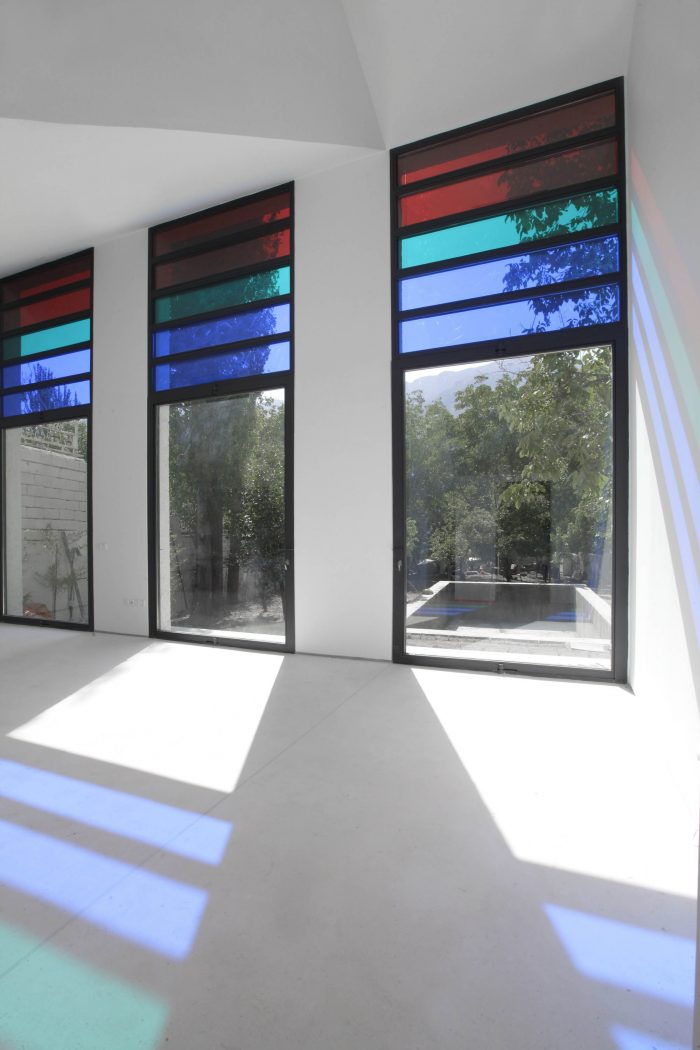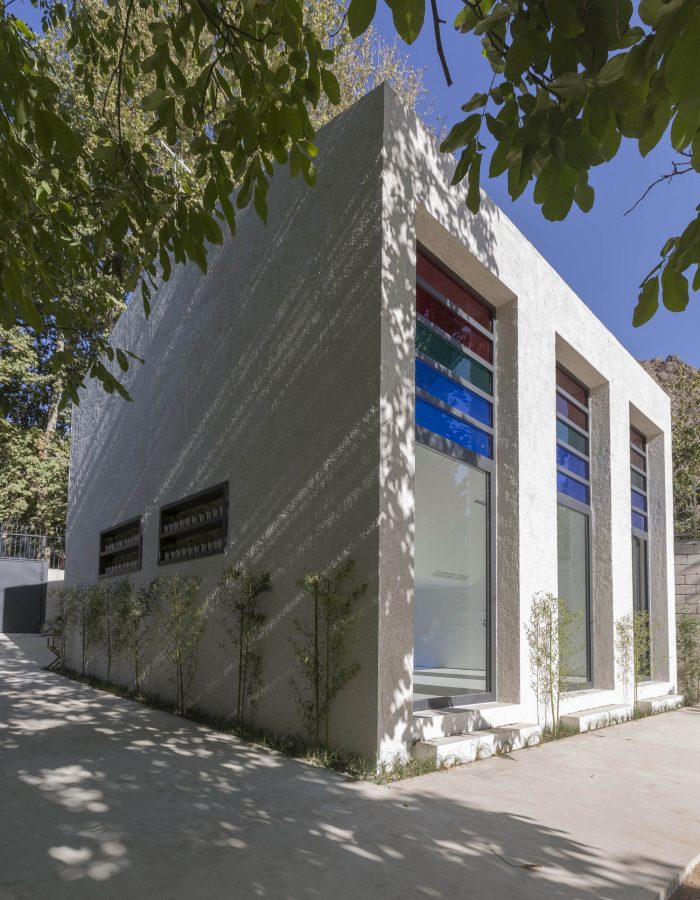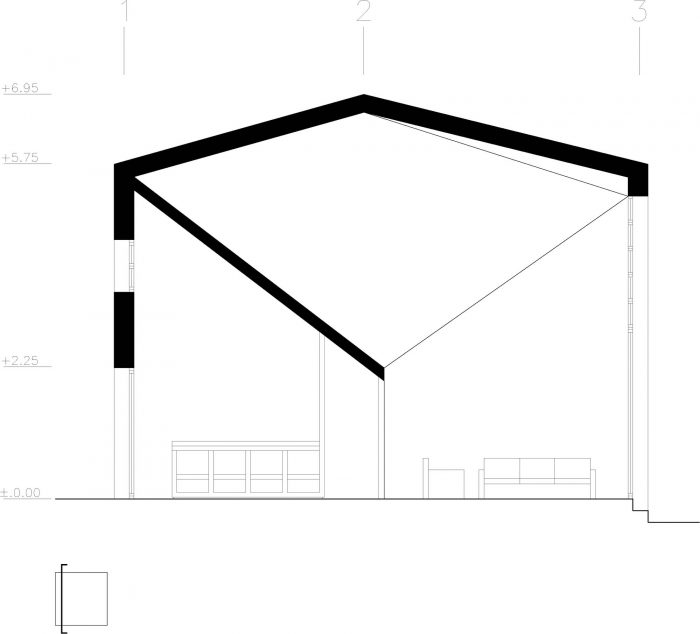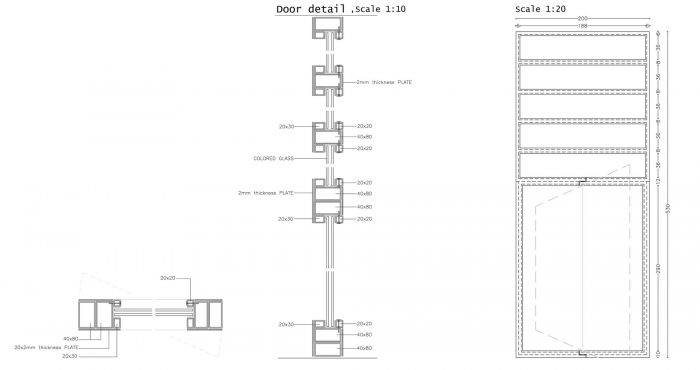Poorkan别墅曾经是一栋丰富的建筑。我们的客户(Mojdeh Ghodousi和Ali Kamran)决定在他们继承的土地上建造一栋别墅。相反,我们鼓励对现有建筑进行改造。
The Poorkan villa used to be an abounded building. Our clients (Mojdeh Ghodousi and Ali Kamran) decided to build a villa on their inherited land. Instead we encouraged the proposition of renovating the existing building on the on.
我们打算循环利用空间,以使其回到有用的当代空间的循环。
我们的客户需要一个别墅作为一个空间,让他们自己和他们的朋友聚集在一起,享受远离日常生活的时光,一个现代生活方式的空间,在这个空间里,人们在朋友圈里就像家人一样亲密。别墅是一家人与亲人相聚的地方,收集正能量,享受乡村的宜人天气。曾经有一栋废弃的带果树花园的二房,位于距离德黑兰仅45分钟车程的波尔坎村,在阿尔博尔兹的山水间。一座建筑就像散落在伊朗各地的成千上万座类似的空旷低质建筑一样,等待着被拆除重建。
We intended to recycle the space, in order to bring it back to the cycle of useful, contemporary spaces.
Our clients were requiring a villa as a space for themselves and their friends to get to gather and enjoy sometime away from the daily life, a space for a modern lifestyle in which inside the circle of friends people are as close as family members to one another. The villa is a place for the family to spend time together with their loved ones, to collect the positive energy and to enjoy the pleasant weather of the countryside. Once there was an abandoned second house with fruit trees garden located in the village of Poorkan just 45 min drive from Tehran, in the mountainous landscape of Alborz. A building like many thousands of similar empty low quality buildings scattered all over Iran, waiting to be demolished and rebuilt.
我们没有遵循这种在社会和经济上不可持续的方式,而是旨在回收利用建筑中150平方米的潜在空间资本。因此,该项目被定义为三个主要战略:修复别墅与当地技术和劳动力,保持现有的结构,整合开放和封闭的空间,以其最充分的空气流动,从花园到最亲密的别墅空间,并达到一个伊朗的空间与光,阴影和颜色下的纯几何结构适应的清晰度。
We didn’t follow this socially and economically unsustainable fashion; instead aiming for a recycling of the potential spatial capital that resided in the buildings’ 150 square meters. Therefore the project was defined with three main strategies: to rehabilitate the villa with local technology and workforce, keeping the existing structure, to integrate the open and closed spaces to their fullest having the flow of air from the garden to the most intimate space of the villa, and to reach an Iranian space with light, shadow and color under the clarity of pure geometry adapted to the structure.
随后,别墅被物化为一个庙宇般的白色空间,重新诠释了伊朗建筑的一些原则。可塑性原则在形式上与清晰的几何和结构是通过两个剑状的切割来实现的,它提供了一个从楼梯到天花板的连续的清晰的空间,并通过使用Sedari-(意为三扇门)这一传统建筑元素,以一种新的方式在室内实现了光、影和色彩的微妙的相互作用的原则。同时,Sedari还完成了室内与花园的统一,让空气属于两者。
The villa was thence materialized into a temple-like white space reinterpreting some principles of Iranian architecture. Principles of plasticity in form with clear geometry and structure was achieved by two sword-like cuts that provide a continuous clear-cut space from the staircase to the ceiling(s), and the principle of delicate interplay of light, shadow and color in the interior by using the Sedari- (meaning three doors) a traditional architectural element- in a new way. The Sedari also does the task of unifying the interior with the garden, letting the air to belong to both.
建筑体量由两层三个相互关联的空间组成。别墅北侧的入口通向一个开放的空间,光影从Sedari中射出。一楼通过楼梯进入轻松宁静的空间,其中有两个宽大的台阶,可以躺在上面静静地度过一段时光。
The building volume consists of three interrelated spaces in two levels. The entrance on the northern side of the villa leads towards an open space ornate with light and shadows coming from the Sedari. The ground floor is elevated through a staircase into the space of ease and serenity in which exists two wide steps performing as resting platforms that one can lie on and spend some quiet time.
Sedari是别墅的支柱。它的功能一如它的传统:当阳光照射到Sedari的彩色窗户时,白色的内部被红色、绿色和黄色的灯光所覆盖,在墙壁上移动,从天花板上爬下来,躺在地板上,创造了一个动态的非物质装饰,随着一天的推移而改变空间氛围。但它的功能还在于,由于它的大尺度,提供了更现代的空间品质:它带来了全透明的空间,并通过超大的门窗,将整个室内变成一个大阳台的可能性。
The Sedari is the anchor of the villa. It functions as it used to traditionally: as the sunlight reaches the colorful windows of the Sedari, the white interior is being clad by red, green and yellow lights, moving up the walls, crawling down the ceiling and lying on the floor, creating a dynamic immaterial ornamentation, changing the spatial ambiance as the day goes by. But it also functions in providing a more contemporary spatial quality due to its large scale: it brings full transparency and the possibility of turning the whole interior into a large balcony with its oversized door-windows.
Poorkan别墅对穆斯林社区的益处在于它的空间特质,以及它生动地再利用传统空间资本并使其回归到空间制造的循环中的方法。以此证实伊朗社区可以为他们的当代艺术和建筑感到骄傲,而不停留在一种状态。考虑到客户对这个项目的预算有限,我们得益于对现有空间的再利用作为基础,并打算对其进行活化,目的是利用当地的建筑材料和简易技术。
Poorkan villa’s benefit to the Muslim community is inherent in its spatial qualities and its approach to vividly reuse the traditional spatial capital and bring it back to the cycle of space making. In this way confirming that the Iranian community can be proud of their contemporary art and architecture, without remaining in a state. Considering the limited budget of our client for this project, we benefited from reusing the existing space as a base and intended to revitalizing it, with the aim of local construction material and easy technology.
目前,该别墅不仅供客户和她的朋友们在周末使用,而且她还计划在一段时间内,让游客和访客在那里居住。考虑到主要的建议是翻新旧建筑,而不是拆除和重建,我们决定用伊朗几何学的先驱原则来证明现有空间的合理性。
As of today the villa is not only in use by the client and her friends during the weekends, but also she is planning to once in a while, let the tourists and visitors to stay there. Considering the main proposal which was to renovate the old building instead of demolishing and rebuilding it, we decided to justify the existing space with the principles of a pioneer Iranian geometry.
因此,在用两个三角剖面来简报项目的想法下,达成清晰的交点是很重要的。最初的问题是让不同厚度的材料层相互叠加,而空间中清晰的剑状切割保持完美执行。一般来说,这个项目中使用的建筑材料都来自伊朗,而且很容易获得。来自伊朗和阿富汗的承包商和工匠大师们利用车间图纸和primavera程序的工具开发了这个项目,以便能够控制我们的时间和足迹。
南立面(Sedari)的超比例门可以从中心点旋转。窗户的钢框架多了一层数控钢板,使其更厚更坚固。这个过程是由德黑兰的Shirzad先生完成的。
Therefore with the idea of briefing the project with two trigonometric sections, it was important to reach clear intersection points. It was an initial matter to have different layers of material with different thicknesses lying on top of each other, while the clear sword-like cuts of the space stay perfectly executed. In general the construction materials used in this project are coming from Iran and easily available. The contractors and master craftsmen from Iran and Afghanistan developed this project with the tools of shop drawings and primavera programs to be able to control our time and footprints.
The over scaled doors of the south façade (the Sedari) is rotatable from the center point. The steel frames of the windows have an extra layer of CNC steel sheets, for them to be thicker and stronger. This process was actualized by Mr. Shirzad in Tehran.
Mohamadreza先生。Sedighi在Karaj制造了大型彩色玻璃,还在需要的地方用彩色Plexi板做了双层玻璃。
所有的当地承包商都非常尊重和可靠。最重要的影响是达到了对现有空间的再利用和翻新的战略,避免了拆除和建造新的建筑。
Mr Mohamadreza. Sedighi who manufactured the large colorful glasses in Karaj, have also made them double glazed with colorful Plexi sheets, where needed.
All the local contractors were very respectful and reliable. The most important impact is reaching to the strategy of reuse and reconditioning of the existing spaces and to avoid demolition and construction of the new builds.
由于伊朗不可持续的经济(以石油为基础的经济),许多新的建筑正在建设。一方面这个过程为许多人创造了就业机会,另一方面由于管理不善,没有任何空间质量的空楼数量在增加。
我们强调剩余空间的潜在价值,等待着被活化。我们意在将人们的视线拖向这块被遗忘的除了高端建筑之外的民族财富。
泊岸别墅不是一个大型项目,但它达到了空间品质的最佳状态。它是我们理念的物理体现。
Due to an unsustainable economy (oil based economy) in Iran many new buildings are being constructed. On one hand this process creates jobs for many people and on the other hand due to mismanagement, the number of empty buildings without any spatial quality is increasing.
We emphasize on the potential value of leftover spaces, waiting to be revitalized. We are intending to drag the attentions to this forgotten national wealth that exists besides the high-end architecture.
Poorkan villa is not a large scale project but it reaches to the optimum of spatial quality. It is a physical manifestation of our idea.
Poorkan别墅是一个被回收利用的剩余空间,它被改造成一个伊朗式的、充满诗意的建筑作品。伊朗人和更大范围内的穆斯林社区,将能在这样的空间里感到自信。它可以改变拆迁的文化习惯,为伊朗当代空间提供另一种选择。
Poorkan villa is a leftover space which has been recycled and transformed into an Iranian and poetic piece of architecture. Iranians and in a bigger scale the Muslim community, would be able to feel confident in such a space. It can change the cultural habit of demolishing and materializes an alternative for an Iranian contemporary space.
建筑师:ZAV Architects
面积:142 m²
年份:2015年
摄影:Soroush Majidi, Parham Taghiof
制造商: Knauf, Noavaran Aida Plastic, Polar Solar Panels
景观:Maryam Maghare
机械工程师:Kianoosh Mohamadi
电气工程师:Ali Ghanizade
土木工程师:Nader Shokoofi
监事:Fateme Rezaie Fakhr-e-Astane
图文:Fateme Rezaee Fakhr-e-Astane
建筑师:Mohamadreza Ghodousi
设计团队:Fateme Rezaie Fakhr-e-Astane, Soroosh Majidi
国家:伊朗
Architects: ZAV Architects
Area: 142 m²
Year: 2015
Photographs: Soroush Majidi, Parham Taghiof
Manufacturers: Knauf, Noavaran Aida Plastic, Polar Solar Panels
Landscape:Maryam Maghare
Mechanical Engineer:Kianoosh Mohamadi
Electrical Engineer:Ali Ghanizade
Civil Engineer:Nader Shokoofi
Supervisor:Fateme Rezaie Fakhr-e-Astane
Graphic:Fateme Rezaee Fakhr-e-Astane
Architect In Charge:Mohamadreza Ghodousi
Design Team:Fateme Rezaie Fakhr-e-Astane, Soroosh Majidi
Country:Iran




































